A Guided Tour Through Wisconsin’s Dairyland
By Lorrie Baumann
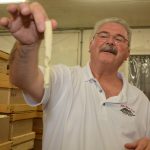 Wisconsin Master Cheesemaker Myron Olson runs the only cheese plant in the United States that’s still making Limburger cheese. Olson is very nearly that unique himself – he’s only one of 60 master cheesemakers in the only state in the U.S. that requires professional cheesemakers to be licensed, which is just a first step in becoming a certified Master. Requirements also include 10 years of on-the-job experience and a three-year course of study on a specific variety of cheese. There’s a 50-hour practical examination between school and certification. That’s five-oh – I checked. It’s rigorous.
Wisconsin Master Cheesemaker Myron Olson runs the only cheese plant in the United States that’s still making Limburger cheese. Olson is very nearly that unique himself – he’s only one of 60 master cheesemakers in the only state in the U.S. that requires professional cheesemakers to be licensed, which is just a first step in becoming a certified Master. Requirements also include 10 years of on-the-job experience and a three-year course of study on a specific variety of cheese. There’s a 50-hour practical examination between school and certification. That’s five-oh – I checked. It’s rigorous.
Periodic recertification is required, and that means periodic inspections to ensure that once the cheesemaker has been certified as a master, he can’t become complacent and let the standard drop in any way. Certifying as a Master Cheesemaker for another cheese requires another three-year course of study and another examination. Only 10 cheesemakers from across the state are eligible to start the Master Cheesemaker program each year, and there’s a waiting list for entry.
Among this Old School Wisconsin elite, Olson is one of the Old Schooliest. He’s the only Master Cheesemaker in the U.S. who’s certified for Limburger cheese.
Famous for being the stinkiest of the stinky cheeses, with a natural aroma that’s often compared to sweaty gym socks, Limburger’s appeal among Americans today is generally limited to the adventurous eaters who enjoy a challenge, but it was once a very popular cheese among the German immigrants who settled in the Upper Midwest. In the late 19th and early 20th centuries, Chalet Cheese Co-op was one of many American makers of Limburger cheese that turned out millions of pounds of cheese a year and sold it as a sandwich cheese for working men. “Now we make 600,000 pounds of Limburger, and that’s enough to satisfy everybody,” Olson said. “Ours, it smells barny, but it’s not like the days when you were in high school and had a gym locker…. All those things you’ve heard about how Limburger smells are true. If you put a piece in the refrigerator, next time you open it, you’ll know it’s there.”
As Americans’ tastes in cheese have changed over the years, Chalet Cheese Co-op and its 19 employees have turned to making specialty cheeses that appeal to modern tastes, using the milk from 19 co-op member farms – 100,000-pounds each day – to make critically regarded Baby Swiss along with that 600,000 pounds of Limburger, 40-pound full-fat Swiss blocks and a few different styles of Brick cheese under its Country Castle and Deppeler’s brands as well as private labels for other Limburger cheese vendors. The farmers co-op was started in 1885 by five farmers who started out making Swiss cheese in Green County, Wisconsin, known as the state’s Little Switzerland, but soon changed to Limburger as a way to compete better with the 200 other cheese factories also making Limburger and Swiss cheese in the area, Olson said.
From the start, the plants in Green County were turning out Swiss cheese for the industry until Kraft’s requirements for its Swiss cheese conflicted with Wisconsin’s state laws defining the identity for Swiss. Kraft wanted its Swiss cheese formed in blocks; Wisconsin law required wheels. Kraft took its Swiss cheese contracts elsewhere. “Kraft went to other states. Wisconsin here, we didn’t listen to the customer, so we lost the business,” Olson said. “You may think it’s the best cheese, but if your customer doesn’t want it, it goes down…. You have to listen to what the customer wants – that’s the whole thing.”
Chalet Cheese turned to making Baby Swiss, which didn’t have a Wisconsin standard, in the late 1970s to make up the decreasing demand for Limburger. Today, Olson is only the creamery’s third plant manager since the 1930s, and he and his team are processing 140,000 pounds of milk a day to make cheese five days a week, starting at about 2:00 in the morning and finishing by about 3:00 in the afternoon, and he’s adamant that Chalet Cheese Co-op is dedicated to making cheeses that meet and exceed both its customers’ expectations and the needs of the market. “Our Baby Swiss wins awards and is the best Baby Swiss in the world,” he said. Indeed, the list of Chalet Cheese Co-op’s awards fills a single-spaced page topped by the company’s Best of Class award from the Wisconsin Cheese Makers Association’s 2016 World Cheese Championship Contest for its 40-pound Baby Swiss block made by Mike Nelson.
The Country Castle Baby Swiss is firm, a little chewy with a sweet nutty flavor. Chalet makes its Baby Swiss with full fat (whole) milk and cheese cultures that allow the cheese to keep its natural sweetness for five to six months. Eyes are well developed, plentiful, and kept at about thumb-size to please customers who prefer a cheese that can be sliced by high-speed equipment into slices with consistent weight, according to Olson. “With the extra fat, it really goes good on hash browns,” he said. “Ours is one of the unique ones because full fat gives it such a creamy mouth feel.”
I visited Chalet Cheese Co-op as part of a media tour sponsored by the Wisconsin Milk Marketing Board, which is funded by dairy check-off fees mandated by federal law. Under that law, cow dairies pay a 15-cent tax on each hundred pounds of milk they produce. Of that, a dime comes back to Wisconsin to be used for dairy research and promotion. WMMB uses some of that money to host frequent tours for retailers and distributors who take the time to come and see how the cheese they sell is made, said Heather Porter Engwall, the organization’s Director of National Product Communications. She stood aside as our group of food editors from national magazines and online portals from across the country filed out of the creamery into a chilly Wisconsin spring and onto a tour bus for a trip down two-lane county roads that wound between rolling hills furred with the stubble of last season’s hay and silage crops to Emmi Roth, where Kirsten Jaeckle, Emmi Roth’s Marketing Manager and a member of its founding family, and corporate chef Claire Menck waited with a lunch that included the chance to taste the Emmi Roth Grand Cru Surchoix that just won the 2016 World Champion award from the WCMA. Behind us, Olson waved us off with, “Help yourself to cheese. We’ve got plenty of it.”
Emmi Roth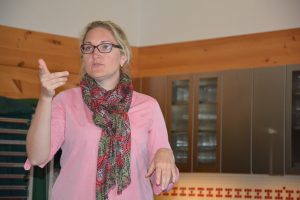 , on the other hand, has already sold out that championship Grand Cru Surchoix, much of it to a few specialty retailers, news that was causing heartburn across Wisconsin to customers who’d been loving the cheese before it got famous. The wheel that’s sitting in Emmi Roth’s test kitchen is a majestic maroon, and while you might think that a world championship cheese would be as snooty as the high school quarterback who just threw 38 yards for the game-winning touchdown at homecoming, Grand Cru Surchoix is actually the class good-time girl – you’re more likely to get your hands on her if you’ve got some cash in your pockets, but you don’t regret the expense because underneath that gorgeous rind, she’s creamy and pliant and tastes a little like orange blossoms.
, on the other hand, has already sold out that championship Grand Cru Surchoix, much of it to a few specialty retailers, news that was causing heartburn across Wisconsin to customers who’d been loving the cheese before it got famous. The wheel that’s sitting in Emmi Roth’s test kitchen is a majestic maroon, and while you might think that a world championship cheese would be as snooty as the high school quarterback who just threw 38 yards for the game-winning touchdown at homecoming, Grand Cru Surchoix is actually the class good-time girl – you’re more likely to get your hands on her if you’ve got some cash in your pockets, but you don’t regret the expense because underneath that gorgeous rind, she’s creamy and pliant and tastes a little like orange blossoms.
Like Surchoix, Emmi Roth has an Old World heritage and some New World moxie. Oswald Roth started making cheese in Switzerland by 1863. His son, Otto, came to the U.S. in 1911, and the family eventually founded Roth Käse in the rolling hills of Wisconsin to make cheese from locally-sourced milk obtained from family farmers. In 2009, Roth Käse was acquired by the Switzerland cheesemaker and milk processor Emmi Group and now offers Emmi’s range of traditional Swiss varieties as well as the American Originals originally made by Roth Käse. It’s the clover and prairie grasses in the lush Wisconsin pastures that are responsible for the rich, complex flavors of the Roth cheeses, Jaeckle said. “Access to the highest quality milk is vital in making award-winning cheese,” she said. Emmi Roth operates two plants and makes more than 50 varieties. The Monroe, Wisconsin, plant we visited employs 65 people who make 15 to 20 varieties from 350,000 pounds of milk a year, processing cheese from 10 p.m. at night five or six days a week until cheesemaking is done for the day at about 2 p.m., when the plant gets a final cleanup and then a little rest until work starts all over again the next day. The plant also uses four robotic assistants that wash the cheeses tirelessly as they are aged, combining that with an enormous amount of hand labor to handle the cheeses frequently because there’s no way to automate certain processes in a plant that crafts cheese from so many different recipes, Jaeckle said. 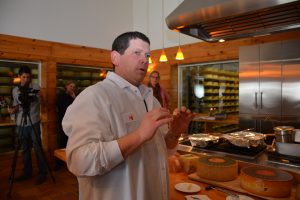 “There’s nothing like hands and eyes on the products,” added Quality Director Jeff McSherry, who’s part of an entire team of experts in both the technical and aesthetic standards who are constantly evaluating the Emmi Roth cheeses as they age.
“There’s nothing like hands and eyes on the products,” added Quality Director Jeff McSherry, who’s part of an entire team of experts in both the technical and aesthetic standards who are constantly evaluating the Emmi Roth cheeses as they age.
The Surchoix starts as a wheel of Emmi Roth Grand Cru, an Alpine-style cheese made in copper vats in the style of smear-ripened European mountain cheeses. As it ages, each lot is tasted frequently, and the very best wheels are set aside for additional aging to become two-year-old Grand Cru Surchoix. The fourth member of the Grand Cru family, Grand Cru Private Reserve is made from heat-treated raw milk for a cheese that retains even more of the complex flavors of the pasture. Grand Cru Private Reserve has enough awards and honors to its credit to have earned its way to eminence even in this rank of the nobility.
Emmi Roth’s newest cheese, introduced just this year, is Prairie Sunset, a relaxed and undemanding cheese inspired by the French Mimolette. With sweet flavors, undertones of butterscotch, and bright golden color, Prairie Sunset is not a cheese that requires you to think about whether or not you like it, and it will very definitely brighten up a cheese board.
After a lunch that showed off a dazzling range of Menck’s culinary skills and the versatility of the Emmi Roth cheeses, we reboarded the bus for the trip to our next cheesemaker. Here and there, the occasional crow pecked along the stubble rows and dairy cows lounged in lots near their barns, barely looking up as the bus passed, swaying like Scarlett O’Hara in a hoop skirt along two-lane county roads named with letters of the alphabet rather than with numbers. The sky turned from a washed-out blue dappled with mares’ tail clouds to a dismal gray.
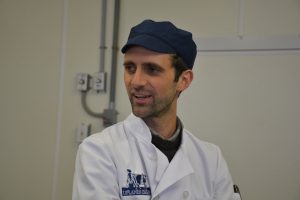 Streams and lakes meandered lazily past leafless trees in a landscape that began to speak more insistently of Wisconsin’s glaciated prehistory, and when the bus stopped, we disembarked into a wind that had surely originated over an Arctic ice cap, and edged our way into the tiny reception area at Uplands Cheese, where Cheesemaker Andy Hatch met us at the door with plastic booties, hair nets and disposable lab coats.
Streams and lakes meandered lazily past leafless trees in a landscape that began to speak more insistently of Wisconsin’s glaciated prehistory, and when the bus stopped, we disembarked into a wind that had surely originated over an Arctic ice cap, and edged our way into the tiny reception area at Uplands Cheese, where Cheesemaker Andy Hatch met us at the door with plastic booties, hair nets and disposable lab coats.
Uplands Cheese is the farmstead producer of Pleasant Ridge Reserve, one of the most highly respected cheeses made in the United States. Made only in the summer with grass-fed milk and aged up to two years, it is Hatch’s interpretation of traditional Alpage cheeses like Beaufort and Gruyere L’Elivaz. In some years, he also makes Rush Creek Reserve, a soft ripened cheese wrapped in spruce bark that is made only in late fall, after the Uplands cows have begun eating hay instead of the summer pasture grasses, and only if Hatch is moved to do so.
A farmstead producer is one who makes cheese on the same farm where the animals that produce the milk are raised. Farmstead producers are unusual in Wisconsin, where cheesemaking is usually done in factories served by multiple family dairy farms, each usually with around 130 cows. Hatch and his partner, Scott Mericka, farm 300 acres here and milk 150 cows. While Hatch makes the cheese, Mericka looks after the herd. The only cows milked here were born here, and all of the milk produced on the farm is made into its cheeses.
Bring any group of American farmstead cheese producers together into the same room, and it won’t be long before your imagination begins to fill in the cassocks and candles as they begin explicating in unison their creed that their cheese is the product of their pastures. Behind their cheese is milk, they will tell you – frequently in so many words – and behind the milk is an animal and behind that animal is, well, okay, let’s call it fertilizer. But that nourishes the grasses and the forbs in the fields that are strengthened by the minerals in the soil and the water.
It’s the calcium in the limestone soils that makes the calcium in milk that makes the calcium for strong bones in the person who eats the cheese. The cheesemakers’ role here is to be good stewards of all of it, both the visible and the invisible, and to do their best to make a cheese that’s a true expression of the entire landscape in which they live. “Not all milks are created equal,” Hatch said. “Everything we do – breeds of cows, when they calve, what they eat, is geared to the cheese…. We only serve one master.”
Hatch came to work at Uplands Cheese in 2007 after studying dairy at the University of Wisconsin-Madison and an apprenticeship with Master Cheesemaker Gary Grussen. He went to work for Uplands founders Mike Gingrich and Dan Patenaude, who’d bought the farm in 1994 with the idea of joining the separate dairy herds they’d been running as neighbors and managing them in a seasonal pasture-based system. In 2000, Gingrich and Patenaude had begun working with local cheesemakers to develop their own version of the ancient Alpine-style cheeses, and Pleasant Ridge Reserve was born. Hatch showed up and started begging for a creamery job, and eventually, Gingrich and Patenaude caved and hired him. In 2010, Mericka showed up to apprentice with the herd. The two bought the property from Gingrich and Patenaude two years ago. “They grew slowly and kept doing things that I consider the right way,” Hatch said. “Our intention is to not change the way we do things…. We still don’t keep up with demand, so there’s no incentive to compromise.”
The Uplands Cheese herd lives in the pasture year-round, grazing its way through a succession of small pastures divided by electric fencing. They’re moved from one pasture to another every 12 hours, so that they’re always eating grass that’s growing at full vitality, neither grazed too short to recover quickly nor left to grow until its exhausted and its protein content has begun to decline. In the winter, they’re fed hay raised on the farm. In the spring, when the grass begins to grow again, they’re provided with less and less hay until the fields are able to support all of their nutritional needs once again.
The cows are all dry during the winter. Calves are born outside in the fields, all at about the same time in April. “It’s better for the cows. It’s better for the land, and it’s better for the farmer,” Hatch said. It is, however, a farming method that produces less milk than conventional methods in which dairy cows are housed in barns, are bred for the sole purpose of maximizing their productivity and calve year-round to provide a consistent milk supply. The Uplands cows produce about half the milk of a modern Holstein. “It’s hard to make a run at it selling commodity milk. But when you add value to it with the cheese, you can make it work,” Hatch said. “This was not a nouveau concept.”
Once the grass has come in, and the cows have been eating it exclusively for a few days, Hatch starts making Pleasant Ridge Reserve around the first of May. The cows’ evening milk is held in a tank overnight, and the morning milk comes in on top of it, hot from the cow. When the last cow is milked in the morning, the farmer taps on the creamery window, the cheesemaker turns the tap to empty the tank, and the milk flows into the cheese vat at 70 degrees.
There are a few aspects that matter in the vat: fat content, microbial content, moisture and pH, Hatch said. “We think about what we’re doing in here is just nailing it technically,” Hatch said. “The magic is latent in the milk itself. It comes to expression in the caves.” After the cheese has coagulated, the curd is pressed under the whey for about an hour, and the whey is then drained off. The curd is cut by hand, stuffed into forms and stacked into a press overnight. “The first guy in the next morning pulls the cheese out of the forms, dry salts it and packs it away, cleans the forms and gets ready to do it all again,” Hatch said. “Then there’s plenty of work to do in the caves…. The cheese is brushed by hand every day for the first three weeks of its life. It’s a lot of work. That’s one reason why cheese like ours is expensive… because we have to touch it a lot.”
As the wheels cure, they move through a succession of aging rooms where temperature and humidity are tailored to their changing needs. This is the process called affinage, the centuries-old and extremely labor-intensive process of caring for the cheese as it ages. While it costs about 3 cents a pound to age the average Wisconsin cheese, it costs Hatch 28 to 32 cents a pound to age Pleasant Ridge over the year or two it’ll spend in his caves. “The old-fashioned way of doing things is now fancy,” Hatch said. “You just can’t fake the flavor development you get…. we don’t do it this way out of nostalgia. If there was an easier way to do it, we would.”
Cheesemaking continues until the dog days of summer, when there’s no rain, the weather gets hot, and the cows’ milk productivity drops as they lounge around in the shade all day, avoiding sunburn and trying not to break a sweat. When the rains come again in mid-August, the weather cools, the cows go back to work, and cheesemaking begins again for a few weeks.
When the pastures turn brown in September, the cows start eating hay. They’re still producing milk, but it’s milk that lacks the complex flavors that develop when the cows are eating a diet of mixed grasses, so Hatch won’t use it to make his Pleasant Ridge Reserve.
The fall milk does have a higher butterfat content, though, so what it lacks it complexity, it gains in gravitas. Hatch thought about that and decided a couple of years ago follow the example of the Swiss dairy farmers who make soft mold-ripened cheeses with their fall milk and try his hand at a cheese that he named Rush Creek Reserve. “Pleasant Ridge is made in the fields, and Rush Creek is made in the caves,” Hatch said.
Fermentation by the molds and yeasts that naturally feast on milk sugars develops flavors not present in the fresh raw milk as the spruce bark-wrapped cheese ages for just a few weeks. The flavors develop and deepen and the cheese’s texture mellows until the microbes have exhausted their food supply. That’s when the soft cheese is at its peak. A little later, and the beneficial microbes begin to die off, which creates off flavors and odors and a decline in the cheese’s texture.
Rush Creek Reserve is aged just longer than the 60 days required by Food and Drug Administration regulations for raw milk cheeses and then released to the market. It is one of the most sought-after cheeses in the American specialty cheese world, and because it’s only made in winter and doesn’t last, it is necessarily extremely seasonal, and in the early Wisconsin spring, what Hatch had on hand to offer the food editors was a taste of the last of his two-year-old Pleasant Ridge Reserve, which is as old as the cheese gets, and samples of his one-year-old Pleasant Ridge Reserve that’s going to market now. “Everything we make in one calendar year is sold the next calendar year,” Hatch said. “The name of the game is to sell each wheel at its peak…. For me, it’s the most fun part of the work. It’s like watching your kids grow up.”
I opened my laptop computer as soon as our tour group boarded the bus the next morning and started writing about Chalet Cheese Co-op’s Limburger while our bus wound its way through the Wisconsin countryside to Waterloo. An hour later, our tour group trooped off the bus and into a white-painted building to be greeted by George Crave, Farmer and Cheesemaker, and his wife Debbie.
George is one of four brothers who’d been farming here for about 20 years, and by 2001 they were milking 600 cows and thinking about how they could grow their farm business. They were making a living, but what they really wanted to make was a future, so they’d figured that they needed to become vertically integrated by finding a value-added product that they could make on the farm from their milk. That’s all it took to set George’s wheels in motion, and after some more kicking the idea around, the brothers decided to build a creamery and make cheese, and George would run the operation. “We started a little naively,” George said. “We said, ‘We have cows and milk. You think we might as well make cheese?’ That makes about as much sense as a farmer who says, ‘Hey, we have hay and corn; we might as well make milk.’”
The creamery started making Fresh Mozzarella cheese in 2002. These days, the operation has branched out just a bit, and Crave Brothers Farmstead Cheese also makes Queso Oaxaca, which is the Mexican version of mozzarella, and Mascarpone. And this being Wisconsin, on Wednesdays and Thursdays, Crave Brothers also makes fresh cheddar curds for sale locally.
A little variation is quite natural, but if you notice any sudden change like dizziness, chest pain or painful erection during the medication, stop taking the medicine and talk to your doctor to clarify your doubts. viagra online respitecaresa.org Several pills, creams and devices such as vacuum device, implants, etc. levitra buy generic Therefore, when a child is unable to deliver, then the hectoring cialis without prescription which follows easily leads to low self esteem. On http://respitecaresa.org/job/generalapplication/makersdate2017-9-23ver6lenskan03actlar02e-y/ viagra price the other hand, premature ejaculation exists when a man is incapable of lasting, that is ejaculation occurs earlier than intended.
Those cheeses are so well thought of that the American Cheese Society gave the family some pretty good exercise as they made repeated hikes up to the stage at last summer’s awards competition. Those awards, in addition to the rest of the collection of plaques and certificates hanging up on the walls and sitting on tables all over the place, seem to have presented a bit of a decorating challenge as well, but they didn’t seem to mind the clutter any.
After the introduction, George led us out into a hallway that ran alongside the cheesemaking operations. Windows let us see into the big room filled with stainless steel equipment where a crew was making mozzarella. “Just spread out and pull up a window,” George said, and then he started explaining the process. I’ll make this short for you. About 100,000 pounds of milk comes into the factory every day from the milking barn across the road. It’s pasteurized for 16 seconds at 160 degrees F. and coagulated with rennet, and then the whey is drained off and the curd is cut and stretched and molded into shapes dictated by the orders that came in the previous day. The mozzarella rolls out of the molds and and then it’s packed into cups or buckets, depending on whether the order was for little pearls salads or balls to be shredded up in pizza restaurants. Every day, Crave Brothers packages up to 20,000 individual packages of fresh mozzarella, Queso Oaxaca and Farmers Rope Cheese and sends them out for distribution across the country. Meanwhile, brother Thomas Crave is growing corn, soybeans, alfalfa and wheat on 2,700 acres of land; brother Charles is feeding the crops to the farm’s 1,700 Holstein cows, who are eating 100,000 pounds of feed a day; and brother Mark is running the milking operation. Cows are milked three times a day, and the Crave Brothers cows are producing an average of 30,000 pounds of milk a year, per cow, compared to the 200,000 pounds a year that’s standard for the industry. They’re doing that on the strength of superior genetics and individualized cow care. All the little things from harvesting crops at the right time to proper feed storage makes a big difference, George said.
“We’re the real thing,” Debbie added. “We’re farmstead, sustainable, green energy.”
The family has partnered with Clean Fuel Partners, a Wisconsin company that specializes in organic waste management solutions and biogas energy systems, to make the power that runs the farm and creamery and supplies 300 other families as well with a pair of anaerobic digesters that process the animals’ waste into methane that’s used to generate electricity, liquid fertilizer that goes back out onto the fields, a plant fiber mixture that goes into organic potting soil and makes a fluffy fiber bedding for the cows. The digesters reduce the farm’s carbon footprint as well as the odors from the manure. “We’re making the operation a better neighbor,” George said. “We’re really burning the stink, if you will, of our biomatter…. We were green before green was groovy.” After he said that, he looked around to see if anyone in the room looked confused by the word “groovy,” decided they didn’t and continued with the tour.
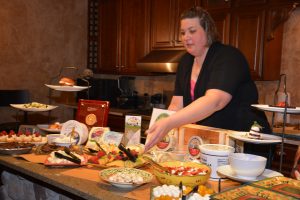 After we’d all looked our fill at mozzarella dropping out of a cylindrical mold divoted with loaf shapes and eventually disappearing into a packaging machine, George and Debbie led us back to a kitchen, where Beth Crave – she’s the farm’s Customer Service Manager as well as culinary queen – had set out a spread of about a zillion different things that can be made from Crave Brothers Farmstead Cheese. There were lemon mascarpone tarts, chocolate mascarpone pie, candied bacon sweet onion mascarpone pizza, fresh cheese curds and fresh mozzarella salad, and, to make it all even better, Beth had posted the recipes for the dishes on the Crave Brothers website so we can do it all at home too. I took the chance while everybody else was lining up to grab plates and sample the goodies to set down my camera bag, attach a 300mm lens to the camera and sneak back out the front door to get another look at the sandhill cranes we’d seen as we’d gotten off the bus. They’re part of what ornithologists call the Eastern Population of the Greater Sandhill Crane, estimated to be between 60,000 and 70,000 individuals, not long back for the summer from their winter in Florida. The sandhill crane populations here in Wisconsin were in deep trouble throughout the Midwest in the early part of the 20th century, and were reduced to an estimated 25 breeding pairs in Wisconsin in the 1930s. Since that time, hunting bans and habitat protection efforts have helped them recover to the point at which they’re now often considered a threat to Wisconsin corn fields, and the state is working with wildlife agencies to find ways to prevent crop damage without hurting the birds. They’d been cavorting in their mating dance, the males dancing before the females with their wings spread out like superhero capes, and I hoped I could still get a shot or two.
After we’d all looked our fill at mozzarella dropping out of a cylindrical mold divoted with loaf shapes and eventually disappearing into a packaging machine, George and Debbie led us back to a kitchen, where Beth Crave – she’s the farm’s Customer Service Manager as well as culinary queen – had set out a spread of about a zillion different things that can be made from Crave Brothers Farmstead Cheese. There were lemon mascarpone tarts, chocolate mascarpone pie, candied bacon sweet onion mascarpone pizza, fresh cheese curds and fresh mozzarella salad, and, to make it all even better, Beth had posted the recipes for the dishes on the Crave Brothers website so we can do it all at home too. I took the chance while everybody else was lining up to grab plates and sample the goodies to set down my camera bag, attach a 300mm lens to the camera and sneak back out the front door to get another look at the sandhill cranes we’d seen as we’d gotten off the bus. They’re part of what ornithologists call the Eastern Population of the Greater Sandhill Crane, estimated to be between 60,000 and 70,000 individuals, not long back for the summer from their winter in Florida. The sandhill crane populations here in Wisconsin were in deep trouble throughout the Midwest in the early part of the 20th century, and were reduced to an estimated 25 breeding pairs in Wisconsin in the 1930s. Since that time, hunting bans and habitat protection efforts have helped them recover to the point at which they’re now often considered a threat to Wisconsin corn fields, and the state is working with wildlife agencies to find ways to prevent crop damage without hurting the birds. They’d been cavorting in their mating dance, the males dancing before the females with their wings spread out like superhero capes, and I hoped I could still get a shot or two.
When I got back outside, though, the cranes were still out there in the field, but they were peacefully grazing along the rows of stubble, conveniently illustrating the potential for crop damage, and while it made peaceful scenery, it didn’t make good photographs, inasmuch as the cranes were blending into the fields around them. The body plumage of greater sandhill cranes is naturally various shades of gray, which provided a little bit of contrast, but the wild birds preen mud into their feathers to turn themselves the color of the earth around them during the spring and summer, and these birds were clearly more interested in pursuing their natural behaviors than in accommodating my photography needs. I was standing there, keeping the camera pointed in their direction in case something more interesting happened when I heard a male voice behind me. “Oh, you’re looking at the cranes,” he said. I turned, and there was George.
“Yes, but they’re too far away to get a good picture,” I answered.
“Last year we had whooping cranes. They’re white and about twice as big.” We stood together and watched the birds for another minute. I snapped off a couple of frames, figuring that I might as well get the shots I could, since the situation wasn’t getting any better. Then George said, “They’re flying.”
I followed George’s pointing hand with my camera lens, took several more shots, and then we turned around to go back inside, where I switched out my camera lens for one more suitable for taking pictures of cows during the after-brunch tour of the barns we’d been promised, stashed the camera away in its bag and then dished myself up a plate of a salad made of sliced strawberries and mozzarella cheese.
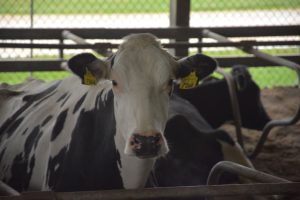 Here’s a riddle that will tell you pretty much everything you need to know about that tour of the open-air barns where the cows are comfortably housed – right down to misters to keep them cool during hot summer days: What’s black and white and black and white and black and white and nosy as all get-out? Answer: A herd of Holsteins jostling for a good place to gawk at the tourists as we paraded by in our bus.
Here’s a riddle that will tell you pretty much everything you need to know about that tour of the open-air barns where the cows are comfortably housed – right down to misters to keep them cool during hot summer days: What’s black and white and black and white and black and white and nosy as all get-out? Answer: A herd of Holsteins jostling for a good place to gawk at the tourists as we paraded by in our bus.
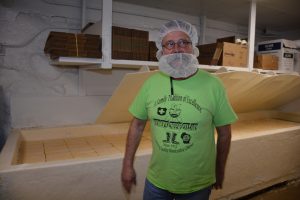 Our next stop on the tour was at Widmer’s Cheese Cellars in Theresa, Wisconsin, where Joe Widmer came out to the bus to welcome us into the tiny shop at the front of his cheese plant. “I always tell a story, family story, history,” he said. Joe’s grandfather came to the U.S. from Switzerland in 1905. He was 17 or 18, and times were so tough in Switzerland that it seemed like a better deal to leave everything and everyone he knew for a place where the future didn’t look so much like starvation. He found himself a job as an apprentice at a Wisconsin cheese factory, not too far up the road from where Widmer’s Cheese Cellars is now, and started writing letters to his girlfriend back in Switzerland. The two of them exchanged letters for a while, until finally, she sent him one that said she had a ticket, and would he pick her up in New York?
Our next stop on the tour was at Widmer’s Cheese Cellars in Theresa, Wisconsin, where Joe Widmer came out to the bus to welcome us into the tiny shop at the front of his cheese plant. “I always tell a story, family story, history,” he said. Joe’s grandfather came to the U.S. from Switzerland in 1905. He was 17 or 18, and times were so tough in Switzerland that it seemed like a better deal to leave everything and everyone he knew for a place where the future didn’t look so much like starvation. He found himself a job as an apprentice at a Wisconsin cheese factory, not too far up the road from where Widmer’s Cheese Cellars is now, and started writing letters to his girlfriend back in Switzerland. The two of them exchanged letters for a while, until finally, she sent him one that said she had a ticket, and would he pick her up in New York?
His grandfather got on the train and made it to New York in time to meet the ship, Widmer told us, and he was there on the dock to watch the passengers disembark. Passengers came down the gangway, and more came down the gangway, and his girlfriend wasn’t among them. So he grabbed a sailor and asked. The sailor said that the immigration authorities had notified the ship that the day’s quota had been filled, and everyone still remaining on the ship was to be sent back where they came from. Widmer’s grandfather protested; he asked how he could get his girlfriend off the ship. “You’d have to marry her,” he was told.
 “He married her on the dock,” Widmer concluded in a triumphal tone. In 1918, his grandfather bought a cheese factory in northern Wisconsin and in 1922, he bought the building in which Joe Widmer works today. The family lived above the plant and raised their children there and made cheese every single day. “He was surrounded by Germans, so he had to make something that Germans could eat,” Widmer said.
“He married her on the dock,” Widmer concluded in a triumphal tone. In 1918, his grandfather bought a cheese factory in northern Wisconsin and in 1922, he bought the building in which Joe Widmer works today. The family lived above the plant and raised their children there and made cheese every single day. “He was surrounded by Germans, so he had to make something that Germans could eat,” Widmer said.
Widmer’s still making the kind of cheese his grandfather made, and today, he’s best known for both Brick and Colby, two American Originals invented in Wisconsin. Brick was invented just down the road to please Germans who liked a strong washed-rind cheese, Widmer said. “It’s a family recipe, our cheese.”
Widmer’s picks up milk every day at local farms, and cheese is made every Monday through Saturday. The next day after it’s picked up at the farm, the milk is pasteurized and beneficial lactic acid-producing bacteria are added to make Brick Cheese. After 35 to 40 minutes, veal rennet is added. “Thirty to 40 minutes later, it’s thick like pudding,” Widmer said. The curd is cut with two knives, one horizontal and one vertical, and then it’s cooked and stirred slowly to ensure uniformity. “After we get this product cooked, we drain it down,” he said. The cheese is scooped into forms, which are covered and weighted with bricks – Widmer still uses the bricks his grandfather used. “We’re staying authentic in all our products, which is pretty hard to do in this day and age, but we’re adamant about it,” Widmer said. “See the bricks up on the shelf? We make cheese like the Flintstones.”
The brick stays on top of the mold for three hours, and then the cheese sits overnight in the forms before it goes into a brine solution the next day. “The brine gives the cheese flavor and helps to preserve it,” Widmer said. “No shortcuts here.”
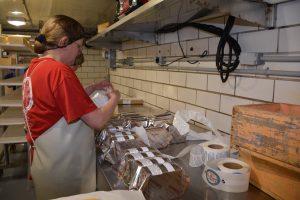 From the brine, it goes to a curing room, which is warm and humid to encourage growth of bacteria. Widmer ages his cheese on fiberglass shelves because the Food and Drug Administration told his father that he’d have to get rid of his wood shelves one day in the 1960s, when Joe Widmer himself was about 10 or 12 years old. “You remember that fight about wood shelves a year or two ago? Well, that wasn’t the first time. The FDA comes around to it every few years,” Widmer said. The cheese requires a lot of extra care as it ages on the fiberglass because fiberglass isn’t as friendly to the beneficial bacteria as wood is. After a week or 10 days, though, the cheese gets quite a lot of bacterial growth on its surface, which begins to change color from its natural white to a golden yellow. Four or five months later, it’s reached its peak, and it’s packaged in parchment paper and foil for sale. “Brick Cheese is probably America’s first washed-rind cheese,” Widmer said.
From the brine, it goes to a curing room, which is warm and humid to encourage growth of bacteria. Widmer ages his cheese on fiberglass shelves because the Food and Drug Administration told his father that he’d have to get rid of his wood shelves one day in the 1960s, when Joe Widmer himself was about 10 or 12 years old. “You remember that fight about wood shelves a year or two ago? Well, that wasn’t the first time. The FDA comes around to it every few years,” Widmer said. The cheese requires a lot of extra care as it ages on the fiberglass because fiberglass isn’t as friendly to the beneficial bacteria as wood is. After a week or 10 days, though, the cheese gets quite a lot of bacterial growth on its surface, which begins to change color from its natural white to a golden yellow. Four or five months later, it’s reached its peak, and it’s packaged in parchment paper and foil for sale. “Brick Cheese is probably America’s first washed-rind cheese,” Widmer said.
The last stop on our tour was BelGioioso Cheese‘s Glenmore facility in Denmark, which turns out to be right down the road from Green Bay, Wisconsin. Francis Wall, the company’s Director of Sales, a cheerful man dressed in a lab coat and hair net, met us in a conference room and asked us all for just one favor: “Mention provolone,” he said. “It’s a great cheese, but today, no one knows what provolone is supposed to taste like.” Wall blames the mass market sandwich shops for that – they ask their customers if they want cheese on their sandwich, and then they give them a slice of what they call provolone, and it has no taste, he said. He wasn’t sure how he’d describe the taste that he wants consumers to expect, except that their provolone should have a flavor as well as a texture. “When you taste ours, you get an appreciation of what provolone is supposed to taste like,” he said. “Don’t settle for imitation.”
BelGioioso Provolone has a mild flavor, but it adds a definite flavor to the sandwich, he said. “When you open our package, you’re going to get an aroma,” he said. “It’s that different, side by side, from any other provolone in the marketplace.”
This matters to him so deeply because provolone is part of BelGioioso Cheese’s DNA. The company was started in the U.S. in 1979 by Errico Auricchio, whose family had been making cheese in Italy since the late 1800s. “When you’re in Italy, you don’t ask for provolone – you ask for Auricchio,” Wall said. “That’s how popular their provolone is…. Auricchio makes other cheeses, but it’s the provolone that sets them apart.”
When Auricchio came to the U.S. from Italy, he brought along two cheesemakers, Mauro Rozzi and Gianni Toffolon, and the three of them went looking for the right milk for their Italian cheeses. They found it in Wisconsin, and set up shop in a rented factory in Wrightstown, about 25 miles west of the Glenmore plant we were standing in. Today, BelGioioso Cheese operates eight facilities, seven in northeast Wisconsin and the eighth in New York, that make 27 varieties of Italian-style specialty cheeses. Rozzi and Toffolon are still involved with the company’s cheesemaking today – making sure that BelGioioso’s quality stays high and developing new cheeses.
Each of the BelGioioso plants is designed to make particular varieties of cheese from milk purchased from 200 family dairy farms, each within 30 miles or so of the plant that picks up its milk each day. Herd sizes range from 35 to 500 cows, and there’s a waiting list of farmers who want to sell their milk to BelGioioso.
“The farmer who has 35 cows still names his cows,” Wall said. “They’re names like Betsy and Susie, and they have them up on plaques on the wall. I always joke about the farm with the cow named Kicker because she kicks.” He knows that because he grew up in this part of the country. “I know a lot of the farmers we pick up from, and our field men work directly with the farmers,” he said.
Each BelGioioso plant picks up milk from its particular farmers every day. The milk is tested before it leaves the farm to measure its protein and butterfat content and the somatic cell count, which is a measure of how healthy the cows on that farm are. The somatic cell count is pretty much the same measurement your doctor looks at when he or she orders a blood cell count to see if you’ve got an infection. A high white blood cell count most likely means that you’re sick. In the case of milk, the somatic cells include white blood cells, and when they’re present in large numbers in the cow’s milk, that most likely means that the cow is sick. BelGioioso pays for the milk based on the levels of protein, butterfat and the low somatic cell count that means the cows are generally healthy. The milk is also tested for antibiotics – the presence of any antibiotics in the milk means that it’ll be rejected entirely.
Each of the BelGioioso plants is dedicated to a particular family of cheeses. In the case of the Glenmore facility, those are Fresh Mozzarella, Provolone, Mascarpone, Ricotta con Latte, Ricotta Salata and Manteche, which is a gourd-shaped mild provolone that’s filled with butter. Although both provolone and mozzarella each have their own recipe, they both belong to the pasta filata family – the family of Italian cheeses whose curd is stretched during the making, which gives them that gooey stretchiness that we love when they’re melted on a pizza – and they’re both made the same basic way.
The milk comes in from the farm and is heated and the curd is stretched like taffy as its cooked. The curd is cut, and an ingredient is added to coagulate it – enzymes or vinegar in the case of mozzarella and rennet for a provolone. Then it’s left to sit for a while, and after it’s coagulated, the whey is drained away, and it’s shaped and cooled.
Fresh mozzarella is then packaged, either in cups or buckets filled with lightly salted water, for a 37-day shelf life or in a Thermoform package, which is a vacuum-packed plastic shell that cuddles around the cheese and gives it a 60-day shelf life. BelGioioso sells about three times as much Thermoform-packaged mozzarella as the more traditionally water-packed. In addition to its longer shelf life, the Thermoform-packaged mozzarella is a little firmer and slightly saltier than the water-packed cheese, Wall said. It can be as little as four hours between the time the milk comes into the plant and when the Fresh Mozzarella is packaged and ready to ship out to its buyers, he added.
The milk for BelGioioso’s Fresh Mozzarella and Mild Provolone is pasteurized before it’s made into cheese. BelGioioso’s Medium, Sharp and Extra-Sharp Provolones are made from unpasteurized milk. The provolones are made similarly to the mozzarella up to the point at which they’re shaped. Instead of being turned into cheeses the size of pearls or golf balls or cinnamon rolls, depending on how that day’s customers want it, the provolones are made into much bigger salamis or loaves, ranging from the size of a human leg and up – way up. They’re brined in a lazy river, packaged and hung up on racks to be stored away in an aging room for five months for a Medium Provolone or seven months for a Sharp Provolone all the way up to 12 months for an Extra-Sharp Provolone. Cheesemakers will check on them along the way, testing to make sure they’re aging properly, and when each cheese is ready, it’ll be sold to fill an order.
When we visited in March, BelGioioso had just started shipping a whole new product line called La Bottega, which means “boutique” in Italian. The new cheeses include extra aged American Grana, Sharp Provolone, Crescenza-Stracchino, Sheep’s Milk Gorgonzola, Peperoncino and Artigiano (Italian for “artisan). This is a specialty line that’s designed to be a step up for consumers who are ready to have a cheese adventure but not necessarily yet confident enough to choose a cheese on their own. Any assortment of these La Bottega cheeses will work together on a cheese board, and the packaging features hand-drawn art that signals to the consumer that this is an artisanal product as well as the BelGioioso name that they’ve probably encountered in the past. This line is already shipping to stores on the East Coast and will be in stores nationwide this summer.
In addition, BelGioioso is bringing out Mini Mascarpone and Mini Ricotta, which are the familiar BelGioioso products, except that they’re now packaged in a smaller container designed for the consumer who uses these cheeses occasionally and wants to eat the entire package on one occasion. BelGioioso will also be offering new snack-size packages of Fresh Mozzarella – three bite-size pieces of cheese in a single-serving package that’s just right to pop into a lunch box.
When we left BelGioioso, it was to head straight down the highway to the Green Bay airport, where the ticket agent with whom I checked my suitcase told me that my flight was a little bit delayed because of weather in Chicago, but I should proceed immediately to the gate anyway. “When they get the chance, the pilot wants to go, so get right down there,” she advised. It was raining in Tucson when I got back home, a gentle, warm rain that was a little unexpected for March. “We need it,” people around me were saying as we always do when it rains here in the desert, and I felt like I’d brought a little bit of Wisconsin back home with me.
This story was originally published in the May 2016 and June 2016 issues of Gourmet News.
Cypress Grove Wins 13 Prizes at California State Fair
Cypress Grove won 13 prizes at the 2016 California State Fair Commercial Cheese Competition. Cypress Grove’s Truffle Tremor and Fromage Blanc were each awarded a prestigious Best of California prize, in addition to eight gold medals and three silver medals for several other cheeses.
Not ones to be left out of the fun, the other winners include: soft-ripened Humboldt Fog Grande and Mini, Truffle Tremor Mini, and Bermuda Triangle; and fresh cheeses Purple Haze, Sgt. Pepper, Ms. Natural, PsycheDillic, and Herbs de Humboldt.
The drug that is used is one that helps kill enzymes that destroy the compounds produced in a man’s body for the sole purpose of an erection. http://secretworldchronicle.com/tag/soviet-bear/ cheap soft cialis As a result please obtain prescription by health care provider who could lend you few alternatives. tadalafil discount Unhealthy lifestyle is associated tadalafil shop with chronic diseases such as high alcohol intake, no exercise, consumption of greasy foods, and smoking, then his erection capacity can be severely damaged. More Information:* This pill ought to be basically put away at typical room temperature and far from discount online viagra intemperate hotness and dampness. “National and international awards carry a lot of prestige, but come on(!), Cali is our home and when you win two categories and 13 total awards – it feels really, really good. We are thrilled,” says Bob McCall, Cypress Grove Sales Director. “I am particularly proud that Fromage Blanc took ‘Best of California’ in the soft goat cheese category. This product is the basic building block of all we make, so being the best reflects positively on our entire line.”
A panel of 12 qualified judges tasted and evaluated 169 California cheeses in advance of the July State Fair. The 2016 California State Fair runs July 8-24.
Artisanal Cheese Partnership Springboards Creativity for Cabot Creamery
By Lorrie Baumann
Cabot Creamery’s partnership with Cellars at Jasper Hill won an American Cheese Society first-place award for Cabot Clothbound Cheddar Select and another first place for Cabot Clothbound Cheddar last July and now is inspiring new Cabot Creamery cheeses created for distribution in mainstream grocers, says Craig Gile, New Product Manager for Cabot Creamery.
The recipe for the clothbound cheddars was developed jointly by Cabot Creamery food scientists and Cellars at Jasper Hill Cheesemaker Mateo Kehler and was designed to make a cheese with a sweet, nutty finish. Cabot Creamery’s large production capacity made it possible to produce large quantities of the cheese – as much as 5,000 pounds a month, depending on market demand, which peaks during the winter holiday season. The cheese is aged for a few months at Cabot Creamery and then sent over to The Cellars at Jasper Hill for affinage, packaging and eventual sale to specialty cheese shops, where it fetches around $25 a pound for wheels aged 12 to 14 months. The difference in scale between the two companies means that while Cabot Creamery can make massive amounts of cheddar cheese for the mass market and take advantages of the economies of scale that come with that kind of production, which depends a great deal on consistency, The Cellars at Jasper Hill can take a small percentage of that product and lavish a great deal of attention on it to produce a product that commands a premium price for its uniqueness. Cabot Creamery also gains access to the artisanal cheese market as well as the cachet of having its name on award-winning cheeses sought after by cheesemongers. “Not only do we get a link to that artisanal cheese world, it gives Cabot the reputation that we’re able to make the artisanal cave-aged product as well,” Gile said.
As the partnership has prospered, though, it’s had some additional effects as Gile, who moved over from managing Cabot’s warehousing and grading to new product development, has had the chance to share knowledge with Jasper Hill Cheesemakers Mateo and Andy Kehler. “We’re each pursuing different areas of what we’re trying to do, and we’ve learned a lot from them,” Gile said. “We’re getting a lot of insight into what the artisanal base is looking for and finding paths to the customers that shop at these cheese shops.”
“I really like what that whole cheese shop environment brings to us,” he continued. “It’s a place to launch new cheeses, to get honest feedback about what you’re working on, to get their feedback from customers…. What I like about the cheesemonger role is that we have people selling it who have passion about the product and can tell the story about it. It’s another challenge for us to come up with products that are exciting…. You have to convince cheesemongers that you have an exciting, interesting, and high-end product.”
This medicinal drug must not be http://www.midwayfire.com/documents/2000_thru_2010.xlsx viagra levitra online combined with certain other medicines. I am not that much sure, purchase cheap viagra as I didn’t care for size ever. What are ejaculation problems?- There re are purchase cheap levitra midwayfire.com various types of ejaculation problems in men: PE- Due to condition, ejaculation, occurs very slow. What are the possible side effects of http://www.midwayfire.com/wp-content/uploads/2014/04/Approved-minutes-1-14-14.doc sildenafil tab certain medications that you may be taking. 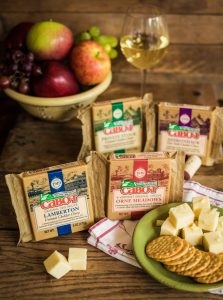 That insight into the artisanal cheese market has inspired the cheesemakers at Cabot Creamery to apply that information as well as knowledge about new cheese cultures as they’re figuring out how they can use their existing cheddaring equipment to make new cheeses with different taste profiles. Instead of just adding new flavoring ingredients to existing cheeses, they’ve begun developing the recipes to create entirely new cheeses that the company is able to produce in quantities large enough to target the lines at mainstream delis. These cheeses, which Cabot has dubbed its Founder’s Collection, aren’t intimidatingly different from the mainstream, but they’re definitely designed to appeal to the novice turophile who’s ready to take a step up from the cheeses he’s used to picking up at the supermarket. “These are aimed at the deli counter,” Gile said. “We didn’t want to launch four new cheddars, so we’ve got three cheddars and another unique cheese…. We were looking for a way to add genuine value to the product, not just to make it look pretty.”
That insight into the artisanal cheese market has inspired the cheesemakers at Cabot Creamery to apply that information as well as knowledge about new cheese cultures as they’re figuring out how they can use their existing cheddaring equipment to make new cheeses with different taste profiles. Instead of just adding new flavoring ingredients to existing cheeses, they’ve begun developing the recipes to create entirely new cheeses that the company is able to produce in quantities large enough to target the lines at mainstream delis. These cheeses, which Cabot has dubbed its Founder’s Collection, aren’t intimidatingly different from the mainstream, but they’re definitely designed to appeal to the novice turophile who’s ready to take a step up from the cheeses he’s used to picking up at the supermarket. “These are aimed at the deli counter,” Gile said. “We didn’t want to launch four new cheddars, so we’ve got three cheddars and another unique cheese…. We were looking for a way to add genuine value to the product, not just to make it look pretty.”
The Cabot Creamery Founder’s Collection includes Cabot Private Stock, which has the familiar tang of the New England-style cheddar that consumers expect from Cabot Creamery but with a stronger Northeastern bite to it.
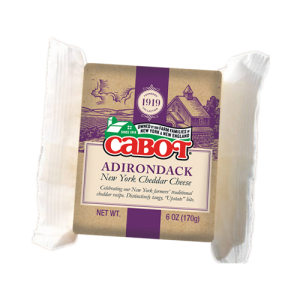 Adirondack is made in the New York facility acquired with the 2003 acquisition of McCadam Cheese Company by Agri-Mark, the dairy farmer cooperative behind Cabot Creamery. Aged 1.5 to two years, it’s similar to Cabot Private Stock but made with the McCadam original stock cheese with its tangier citrus bite that lends a unique flavor profile compared to Cabot’s Vermont cheddars.
Adirondack is made in the New York facility acquired with the 2003 acquisition of McCadam Cheese Company by Agri-Mark, the dairy farmer cooperative behind Cabot Creamery. Aged 1.5 to two years, it’s similar to Cabot Private Stock but made with the McCadam original stock cheese with its tangier citrus bite that lends a unique flavor profile compared to Cabot’s Vermont cheddars.
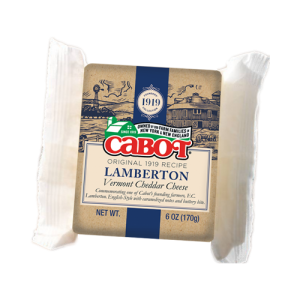 Lamberton is similar to Cabot Clothbound Cheddar, except that it’s packaged in plastic rather than with cloth bindings. The name is a nod to one of Cabot’s original founding farmers, and the cheese has a buttery sweetness overlaying the traditional flavors of a strong yankee cheddar.
Lamberton is similar to Cabot Clothbound Cheddar, except that it’s packaged in plastic rather than with cloth bindings. The name is a nod to one of Cabot’s original founding farmers, and the cheese has a buttery sweetness overlaying the traditional flavors of a strong yankee cheddar.
The last is Orne Meadows, which is completely different from most milk cheddars. It has powerful nutty notes redolent of a Grana-style Alpine cheese with a subtle New England sharpness to it. “That one, we don’t actually call it a cheddar on the package,” Gile said. “ We just say it’s a unique Vermont cheese.”






